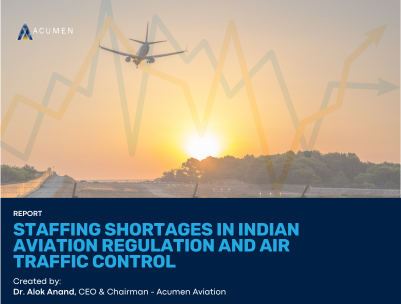10 Sep 2025
Staffing Shortages in Indian Aviation Regulation and Air Traffic Control

Why This Article Is Essential
India’s aviation sector is expanding at pace, with passenger traffic projected to double over the next decade. Yet this growth is under serious threat from a critical shortage of skilled staff at the Directorate General of Civil Aviation (DGCA) and within air traffic control (ATC). A parliamentary committee has already warned that these deficits undermine safety oversight, with the risks starkly highlighted by the Air India Flight 171 crash in June 2025.
Understaffing is driving fatigue among controllers, slowing certification processes, and weakening compliance with international standards. Left unchecked, these gaps pose systemic safety, reputational, and operational risks that could compromise India’s status as a leading global aviation hub.
Authored by Dr. Alok Anand, CEO & Chairman of Acumen Aviation, this report examines the scale of the challenge, its root causes, and the roadmap for reform. It provides a structured framework of immediate, medium-term, and long-term actions designed to restore resilience, strengthen regulatory credibility, and ensure the safe growth of Indian aviation.
What You’ll Learn
Current State of Play: The scale of DGCA vacancies, overstretched ATC staff, and the imbalance between regulatory capacity and fleet expansion.
Key Risks: Safety, operational, reputational, and legal liabilities arising from workforce shortages.
Root Causes: From lengthy recruitment processes and limited training infrastructure to uncompetitive pay and short-term staffing policies.
Recommendations: A strategic mix of workforce forecasting, accelerated recruitment, expanded training, and compensation reforms.
Medium-Term Reforms: Expanding training academies, international exchange programmes, and AI-driven safety oversight tools.
Immediate Priorities: Filling 190 DGCA vacancies, launching emergency ATC hiring, and digitising licensing processes.
Long-Term Vision: Transitioning DGCA into an independent authority, establishing a national aviation talent pipeline, and positioning India as a regional hub for aviation safety expertise.
Current State of Play: The scale of DGCA vacancies, overstretched ATC staff, and the imbalance between regulatory capacity and fleet expansion.
Key Risks: Safety, operational, reputational, and legal liabilities arising from workforce shortages.
Root Causes: From lengthy recruitment processes and limited training infrastructure to uncompetitive pay and short-term staffing policies.
Recommendations: A strategic mix of workforce forecasting, accelerated recruitment, expanded training, and compensation reforms.
Medium-Term Reforms: Expanding training academies, international exchange programmes, and AI-driven safety oversight tools.
Immediate Priorities: Filling 190 DGCA vacancies, launching emergency ATC hiring, and digitising licensing processes.
Long-Term Vision: Transitioning DGCA into an independent authority, establishing a national aviation talent pipeline, and positioning India as a regional hub for aviation safety expertise.
Who Should Read This
Aviation Regulators & Policymakers
Airlines & Fleet Operations Leaders
Investors, Lessors & Industry Stakeholders
Aviation Regulators & Policymakers
Airlines & Fleet Operations Leaders
Investors, Lessors & Industry Stakeholders
About Acumen Aviation
Founded in 2009 and headquartered in Dublin, Acumen Aviation is a global leader in aviation consultancy, advisory, and asset management. With offices in India, China, and the USA, Acumen delivers clarity and competitive advantage across the aircraft lifecycle through consultancy, asset management, and digital platforms like SPARTA.
Plan Smarter. Strengthen Oversight.
Download your complimentary copy of Staffing Shortages in Indian Aviation Regulation and Air Traffic Control to understand the systematic risks and strategic solutions needed to safeguard India's aviation future.
Have questions? Connect with us at connect@acumen.aero to learn more.

